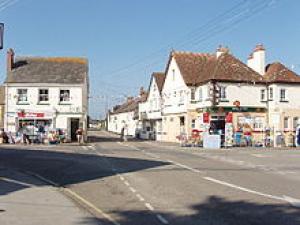


Inland village close to many beaches
The village is about four miles south of the fishing port of Padstow on the B3276 and eleven miles north-east of the coastal resort of Newquay. It has a post office, primary school, veterinary practice, various shops, restaurants, and public houses centred on the crossroads. The population at the 2011 census was 1,692.
St. Merryn village has a tourism motto "Seven bays for seven days", displayed on the road signs as you enter the village. The bays include (from west to east) Porthcothan Bay, Treyarnon Bay, Constantine Bay, Booby's Bay, Mother Ivey's Bay, Harlyn Bay and Trevone Bay. The nearest bay to St. Merryn village centre is Harlyn Bay (one mile north). Interesting features include the seaside cliffs, like the Marble cliffs, Tregudda gorge, Trevose Head and the collapsed cave known as Round Hole. The North Cornwall Coastal Path follows the cliff-tops and crosses the Seven Bays. Only one of these, Booby's Bay has no beach at the highest tides, the ribs of a wrecked ship appear periodically as the sand is relocated by the sea and prevailing currents. The widest beaches at low tide are Harlyn Bay and Constantine Bay. All the bays have fine golden sands and a backdrop of either rocky cliffs or sand-dunes, and all are popular with families as well as swimmers and surfers. The B3276 is the largest road passing through the Seven Bays area.
RNAS St. Merryn operated from 1937 to 1956 was also known as the HMS 'Vulture' and HMS 'Curlew'. Initially the airfield was built with an airstrip and one hangar for civil purposes. In 1940, following construction of buildings for military use, it became an aircraft training centre for training for airborne observers and aircraft carrier flight manoeuvres. The airfield was renamed the RNAS St. Merryn, HMS Vulture at that time. The following year German aircraft bombed the field; it was rebuilt in 1942. The Ward Room was housed within the Cornish Arms Inn; there is an honour roll posted at the location commemorating the aviators of the St. Merryn air field. In 1952 the HMS Curlew unit joined the airfield for Naval reserve and airborne observer training. The field was closed for military purposes in 1956. There is limited aviation on the landing strips now and some of the former airfield is used for industry, farm land and leisure activity. The control tower and other airport buildings are visible in the area.
In August 1999 beef from a St. Merryn slaughterhouse made the national news when it was the source of the first beef from the British mainland to be served in Brussels in three years.
The original dedication of the church was to St. Merryn but in Norman times the saint was assumed to be a St Marina. The first resident Vicar, John de Withiel, was installed on 2nd July 1259. The church building is of Norman foundation but the chancel, south aisle and upper part of the tower are of the 15th century. The font of Cataclewse stone, quarried on Trevose Head, has carved figures of the twelve Apostles. It originally belonged to the chapel of St. Constantine in the parish. Jonathan Toup was a prominent Vicar of St. Merryn, 1776-1785. A small marble tablet erected to his memory by his niece Phillis Blake is on the south wall of the church. The annual summer Church Fete "Roses Day Fun" is on Feast Day Sunday (nearest Sunday to 7th July), with stalls and activities in 'The Young Men's Green'.
The ruins of the Medieval St. Constantine chapel include what is likely the 20 feet high walls of the west tower. The shale and slate stone church was estimated to have been 40 by 24 feet with a "nave and chancel, south aisle and west tower". The chapel was re-roofed in 1290, on orders from the Bishop of Exeter so the Vicar of St. Merryn could hold mass on Sundays, Wednesdays and Fridays. The chapel's font is now in the parish church at St. Merryn. Near the chapel ruins is a holy well which was uncovered in 1911. Taking the waters there was said to bring rain during dry weather. The ruins of the chapel still exist in the dunes (now a golf course) near Trevose.
The St. Merryn Methodist Church is a Wesleyan Methodist chapel which was completed in 1905. It is a single-storied building with a rectangular plan, two light windows and a slate roof. The original early 19th century chapel, made of stone rubble with a slate roof, was also a single-storied building with a rectangular plan. The building, with a two-windowed front and that sits close to the road, is now the site of an arts and crafts centre.
In the summer, St. Merryn hosts a number of activities including the Great Atlantic Raft Race, St. Merryn Vintage Steam Rally, St. Merryn Carnival and other local festivals and community events. 'The Amazing Maize Maze' is sometimes held in the area. The Community Hall hosts auctions and events. The local stables for horse riding are Tina's Riding Stables.
The past industries include tin-mining, smuggling, and fishing. Now, farming and tourism are the prime industries. There are two old public houses in St. Merryn, Farmers Arms and Cornish Arms; the latter was taken over in 2009 by celebrity chef Rick Stein.
St. Merryn Steam and Vintage Rally - End of June.
St. Merryn Carnival - Mid August.
The Camel Estuary Harlyn Bay Padstow Trevone Trevose Head Prideaux Place Treyarnon Wadebridge
Trevose Head Lighthouse Trevibban Mill Porthcothan Bay The Coastal Footpath Cornwall's Beaches